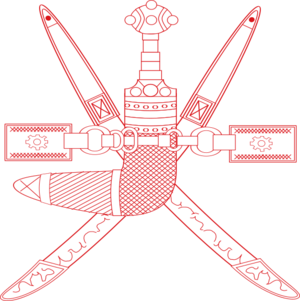Coat of arms of Oman facts for kids
The National Emblem of Oman (which is called شعار سلطنة عمان in Arabic) is a very important symbol for the country of Oman. It shows a traditional Omani khanjar (a type of curved dagger) placed on top of two crossed swords. This design is a very old and powerful symbol of Oman.
You can find this emblem in many places. It is on Oman's flags, on their money, and even on the planes of the Omani Air Force. It represents the country's history and strength.
Contents
What is the Omani Emblem?
The Omani emblem is a unique design. It features two curved swords that cross each other. On top of these swords, there is a special dagger called a khanjar. The khanjar is a traditional Omani weapon. It is known for its curved blade and detailed handle.
This emblem is more than just a picture. It tells a story about Oman's past. It shows the country's long history of defending itself. It also highlights the importance of traditional Omani culture.
The Khanjar: A Symbol of Oman
The khanjar is a very important part of Omani culture. It is not just a weapon. It is also a symbol of a man's status and honor. Many Omani men wear a khanjar on special occasions. They often wear it with their traditional clothes.
The khanjar in the emblem shows Oman's pride. It represents the country's strong traditions. It also symbolizes the courage of its people. The design of the khanjar in the emblem is very detailed. It shows the beauty of Omani craftsmanship.
The Crossed Swords: Protecting the Nation
The two crossed swords in the emblem stand for protection. They show Oman's readiness to defend its land. They also represent the country's military strength. Historically, swords were used for defense. They were also used to keep peace.
The swords remind everyone of Oman's long history. They show how the country has always protected its freedom. Together, the khanjar and swords create a powerful image. They represent Oman's heritage and its future.
History of the Emblem
The design of the Omani emblem is very old. It has been used for many centuries. It first appeared on the royal standard of the Al Said dynasty. This is the ruling family of Oman. The emblem has been a symbol of their power. It has also represented the country's independence.
The current design of the emblem was officially adopted in 1971. This was after Sultan Qaboos bin Said Al Said came to power. He made many changes to modernize Oman. The emblem became a clear symbol of the new, modern Oman. Yet, it still honored its ancient roots.
How the Emblem is Used Today
The National Emblem of Oman is seen everywhere in the country. It is on the national flag. The flag has red, white, and green stripes. The emblem is placed in the upper left corner. This shows its importance to the nation.
You can also see the emblem on government buildings. It is on official documents. It is even on the uniforms of the Omani police and military. This shows that it is a symbol of the state. It represents the government and its authority.
The Emblem on Currency and Stamps
The emblem is also featured on Omani currency. You can see it on banknotes and coins. This helps people recognize their money. It also reminds them of their national identity.
It is also used on postage stamps. When you send a letter from Oman, you might see the emblem. This helps to promote Oman's image around the world. It shows the country's unique culture.
Meaning of the Emblem
The Omani emblem has deep meaning. It represents several important ideas. It stands for the country's rich heritage. It also symbolizes its strength and independence.
The khanjar shows the traditional values of Oman. It represents honor, courage, and pride. The crossed swords symbolize justice and protection. They show Oman's commitment to peace. They also show its ability to defend itself.
Together, these elements create a powerful message. They show Oman as a country that respects its past. They also show it as a country that is strong and independent. The emblem is a source of pride for all Omanis.
See also
 In Spanish: Emblema nacional de Omán para niños
In Spanish: Emblema nacional de Omán para niños


